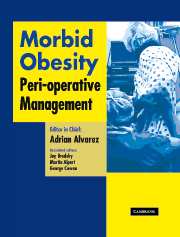Book contents
- Frontmatter
- Contents
- Contributors
- Foreword
- Preface
- Acknowledgments
- Dedication
- Section 1 General aspects
- Section 2 Pathophysiology
- Section 3 Pre-operative management
- Section 4 Peri-operative management of co-morbidities
- Section 5 Pharmacology
- Section 6 Monitoring
- Section 7 Intra-operative management
- 20 Positioning the morbidly obese patient for surgery
- 21 Airway management
- 22 Inhalational anesthesia
- 23 Total intravenous anesthesia
- 24 Anesthetic management for the obese parturient
- Section 8 Post-operative care
- Section 9 Conclusions
- Afterword
- Index
20 - Positioning the morbidly obese patient for surgery
from Section 7 - Intra-operative management
Published online by Cambridge University Press: 17 August 2009
- Frontmatter
- Contents
- Contributors
- Foreword
- Preface
- Acknowledgments
- Dedication
- Section 1 General aspects
- Section 2 Pathophysiology
- Section 3 Pre-operative management
- Section 4 Peri-operative management of co-morbidities
- Section 5 Pharmacology
- Section 6 Monitoring
- Section 7 Intra-operative management
- 20 Positioning the morbidly obese patient for surgery
- 21 Airway management
- 22 Inhalational anesthesia
- 23 Total intravenous anesthesia
- 24 Anesthetic management for the obese parturient
- Section 8 Post-operative care
- Section 9 Conclusions
- Afterword
- Index
Summary
Introduction
The incidence of significant obesity is rising throughout the entire world. As a result every anesthesiologists must be familiar with the management of morbidly obese patients, not only for bariatric procedures but for all types of surgery.
Any surgical patient can experience serious physiologic impairment and even physical injury if improperly positioned during surgery. Positioning considerations are even more important for the morbidly obese patient. It is therefore surprising that many reviews on the peri-operative management of the obese patient fail to discuss the effects of position on cardiopulmonary physiology.
This chapter reviews the implications of the different intra-operative positions on the morbidly obese patient. A patient is considered to be morbidly obese if their body mass index (BMI = weight (kg)/height (m2)) is greater than 39 kg/m2.
General considerations
For any procedure clear and open communication and careful planning between the anesthesiologist and the surgical team is essential. All needed equipment must be identified, be available, and be in working condition before the start of the surgery.
Operating room gurneys are usually too small or too uncomfortable for a very obese patient. Transfer of a morbidly obese patient, both to and from the operating room, is best accomplished with the patient on a hospital bed. Special beds are available to accommodate patients heavier than 200 kg.
- Type
- Chapter
- Information
- Morbid ObesityPeri-Operative Management, pp. 273 - 286Publisher: Cambridge University PressPrint publication year: 2004

